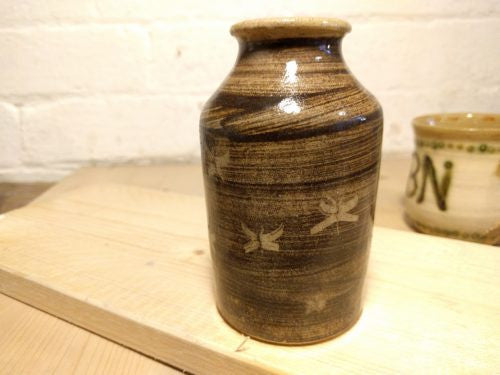
Stoneware Single Firing Schedule and Results
Share
This is a follow up to my article on raw glazing single firing experiments.

Single firing results
Whilst loading the kiln I had a problem with glaze flaking off, especially around the rims. I had to rebrush glaze onto most of the pots. The clay content of both glazes is quite high which I believe is the problem.
I’ve included my notes on the firing. I think the firing schedule itself was ok, I had no breakages, and can’t see any pinholing or bloating which are associated with firing too fast. I did have a major problem with glaze crawling. I think every pot had at least a little bit, and some a lot of crawling. With crawling, the glaze is not adhering properly to the pottery, islands of open clay appear in random locations.

In my case, from what I’ve read it seems the high clay content of the glaze is probably the culprit. As I was working with bone dry pots, the shrinkage of the glaze doesn’t match that of the body, and a weak bond is created. These glazes have been ok when used on bisque pieces, but it seems they are not going to work for raw glazing.
I need to do some more reading, but I think I will reformulate my glazes with around 10% clay next time. I may also look at additives which will give a more flexible glaze.

I was pretty disappointed when I opened this kiln load, but at least I have learnt some things. It gave me an idea of how my slip decoration looks once fired, and which slip formulas are working. I’m still keen to make single firing work for me, so i think it’s worth doing some more experimenting.
Single firing manual kiln schedule
10am start, bottom 2 switches at number 3, lid propped open. Kiln is 75% full with bone dry small pieces.
10.30am water condensing on mirror above spyholes.
1pm no condensation visible on mirror, close lid, turn top switch to lo. May have dried sooner, but I was out shopping so couldn’t check.
2pm top of kiln started to glow dull red, water vapour present at peephole, no change to controls.
3pm a little vapour, bottoms two knobs turned up to 4.
4pm whole kiln red/orange bottom switches turned to 5, top switch to 2. No vapour
5pm top switch to 3, bottom switches to 6
6pm bottom switches to full, top switch to 5
7pm all switches full, top side spyhole plugged.
9pm cone 7 down, I decided to end firing, all switches off

4 comments
Thanks Brett! Funny you should say that, I am currently drying out some of my clay body and intend to make a glaze with that, for the reasons you mention about shrinkage. I would love a pyrometer, just can’t afford one at the moment. I did look at some cheap ones from eBay but not sure about their reliability.
Hi Tom
So glad to read about your raw glazing. I’ve been making ceramics professionally for the last few years and never bisque. I would have to agree with Simon and say they pure joy of it is priceless. For me to bisque a pot just takes the life right out if it.
I dip, pour and spray my glazes that are then fired to cone 9. I also make my own clay body from scratch so can put the base clay into my glazes. This allows both shrink at the same rate.
Crawling can be caused by many things. One of which is to fire too quickly between 427’c and 593’c this can make the chemical water release too quickly and they glaze peel off. Surface tension also causes crawling. Need to research your glaze ingredients. And maybe get a pyrometer.
I certainly hope you continue on your way with this.
Thanks for your message Simon, I’ve just ordered the book you suggested. Hopefully it will inspire me to give single firing another go. Have you got a link to any things you have made, or any suggestions how to overcome the crawling problems I had? ?
Decorating pots raw is simply lush.
You are working with cream and chocolate, everything is soft and smooth, is really does warm my heart . Colours flow and remain wet so that you can allow them to interact, massage and caress then for effect….
Once experienced, I could never go back to that hard, chalky and clinical surface of bisque
True, it is tough getting methods perfected and consistent; but I believe that that is mostly down to the required knowledge being lost through the generations due to industrialisation. Not because it is an inherently bad approach.
“Single Firing” by Fran Tristram is a good read.
I hope you carry/ied on with your experiments, but not for the fuel & time savings – just the pure joy ?